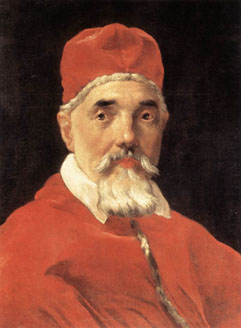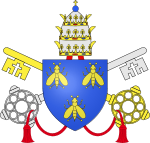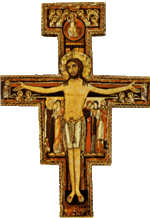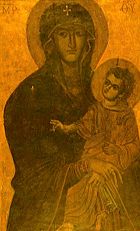Pope Urban VIII
| Urban VIII | |
 |
|
| Papacy began | August 6, 1623 |
|---|---|
| Papacy ended | July 29, 1644 |
| Predecessor | Gregory XV |
| Successor | Innocent X |
| Birth name | Maffeo Barberini |
| Born | April 5, 1568 Florence, Italy |
| Died | July 29, 1644 (aged 76) Rome, Italy |
| Other popes named Urban | |
Pope Urban VIII (baptised 5 April 1568 – July 29, 1644), born Maffeo Barberini, was Pope from 1623 to 1644. He was the last Pope to expand the papal territory by force of arms, and was a prominent patron of the arts and reformer of Church missions. However, the massive debts incurred during his papacy greatly weakened his successors, who were unable to maintain the Pope's longstanding political or military influence in Europe. He was also involved in a controversy with Galileo and his theory on heliocentrism during his time.
Contents |
Early life
Maffeo Barberini was born in 1568 to an important Florentine family. He was educated by the Jesuits and received a doctorate of law from the University of Pisa in 1589.
In 1601, Maffeo was able to use the influence of an uncle who had become apostolic protonotary to secure an appointment by Clement VIII as papal legate to the court of King Henry IV of France. In 1604 Clement VIII appointed him archbishop of Nazareth, although this was an honorary position as the Holy Land was under Turkish rule.
By Clement VIII he was himself made protonotary and nuncio to the French court; Paul V also employed him in a similar capacity, afterwards raising him to the cardinalate and making him the papal legate to Bologna. On 6 August 1623, he was chosen successor to Gregory XV and took the title Urban VIII.[1]
Papacy
| Papal styles of Pope Urban VIII |
|
|
|
|
| Reference style | His Holiness |
| Spoken style | Your Holiness |
| Religious style | Holy Father |
| Posthumous style | His Holiness |
Urban's papacy covered twenty-one years of the Thirty Years' War and was an eventful one even by the standards of the day. He canonized Elizabeth of Portugal and Andrew Corsini and issued the Papal bull of canonization for Ignatius Loyola and Francis Xavier, who had been canonized by his predecessor, Gregory XV.
Despite an early friendship and encouragement for his teachings, Urban was responsible for summoning Galileo to Rome in 1633 to recant his work.
He was the last to practice nepotism on a grand scale: various members of his family were enormously enriched by him, so that it seemed to contemporaries as if he were establishing a Barberini dynasty. Urban was also a clever writer of Latin verse, and a collection of Scriptural paraphrases as well as original hymns of his composition has been frequently reprinted.
Urban VIII issued a 1624 papal bull that made smoking tobacco punishable by excommunication,[2] because he believed it led to sneezing which too closely resembled sexual ecstasy. Pope Benedict XIII would later repeal the ban. [3]
A 1638 papal bull protected the existence of Jesuit missions in South America by forbidding the enslavement of natives who joined a mission community.[4] At the same time, Urban repealed the Jesuit monopoly on missionary work in China and Japan, opening these countries to missionaries of all orders.[5]
Politics
Urban's military involvement was aimed less at the restoration of Catholicism in Europe than at adjusting the balance of power to favour his own independence in Italy. In 1626 the duchy of Urbino was incorporated into the papal dominions, and in 1627 when the direct male line of the Gonzagas in Mantua became extinct, he controversially favoured the succession of the Protestant Duke of Nevers against the claims of the Catholic Habsburgs.

He was the last Pope to extend the papal territory, and fortified Castelfranco Emilia on the Mantuan frontier and the castle of Sant'Angelo in Rome. Urban also established an arsenal in the Vatican and an arms factory at Tivoli, and fortified the harbour of Civitavecchia.
For the purposes of making cannon and Vatican decoration, massive bronze girders were pillaged from the portico of the Pantheon, leading to a famous quote quod non fecerunt barbari, fecerunt Barberini, "what the barbarians did not do, the Barberini did."[5]
Art
In addition to these warlike activities, Urban patronized art on a grand scale. He expended vast funds to bring polymaths like Athanasius Kircher to Rome, and painters Nicolas Poussin and Claude Lorrain, architects Bernini and Borromini were commissioned to build the Palazzo Barberini, the college of the Propaganda, the Fontana del Tritone in Piazza Barberini, the Vatican cathedra and other prominent structures in the city. He also rebuilt San Sebastiano al Palatino on the Palatine Hill.
Pietro da Cortona embellished the gran salon of his family palace with an apotheotic allegory of the triumph of the Barberini.
A consequence of these military and artistic endeavours was a massive increase in papal debt. Urban VIII inherited a debt of 16 million scudi, and by 1635 had increased it to 28 million. By 1640 the debt had reached 35 million scudi, consuming more than 80 percent of annual papal income in interest repayments.[6]
Later life
Urban's death (July 29 1644) is said to have been hastened by chagrin at the result of the First War of Castro, a war he had undertaken against Odoardo Farnese, the Duke of Parma. Because of the costs incurred by the city of Rome to finance this war, Urban VIII became immensely unpopular.
On his death, the bust of Urban that lay beside the Conservator’s Palace on the Capitoline Hill was rapidly destroyed by an enraged crowd, and only a quick-thinking priest saved the sculpture of Urban belonging to the Jesuits from a similar fate.[7]
He was succeeded by Innocent X.
Private Revelation
In many books that promote various (and alleged) private revelations, there is a disclaimer in the beginning of the book(s) that quotes an alleged saying of Pope Urban VIII. It is typically quoted as follows:
"In cases which concern private revelations, it is better to believe than not to believe, for, if you believe, and it is proven true, you will be happy that you have believed, because our Holy Mother asked it. If you believe, and it should be proven false, you will receive all blessings as if it had been true, because you believed it to be true."[8]
Books promoting alleged private revelations typically do not give a citation for this supposed quote. Combined with a vast multiplication of the 'quote' in print, the origin of the above quote has become terribly obscured. Pope Urban could have made the quote but no proof has been provided.
What is known of Pope Urban VIII on the subject of alleged private revelations can be found in his Bull Sanctissimus Dominus Noster of 14 March 1625. He explicitly states that no one can print anything on alleged private revelations without the consent of the local Bishop or the Apostolic See:
"Similarly, and first among other matters, he [Pope Urban VIII] prohibited books about those people, who were famous when they left this life with a reputation or rumor of sanctity or martyrdom, containing the deeds, miracles, revelations, or whatever benefits received from God as through their intercessions, without the recognition and approval of the Ordinary, who, in giving recognition to them, should call into council theologians and other pious and learned men" (Sanctissimus Dominus Noster, 2).[9]
The terms of Sanctissimus Dominus Noster influenced the popes up to and including Pope St. Pius X (1903-1914) and Benedict XV (1914-1922). Pius X referenced it (without precisely naming the document) in his famous Encyclical, Pascendi Dominici Gregis in paragraph 55.[10] Pope St. Pius X upholds the teachings of Sanctissimus Dominus Noster and orders them to be made known in the Church.
Sadly, however, many Catholics have twisted St. Pius X's teaching. Pius X permitted private revelations to be printed with the approval of the local ordinary (and with the insertion of Urban VIII's Bull). Nowadays, many Catholics take the alleged quote (not the Bull) as their banner and believe they can promote alleged revelations without permission from the local Bishop. The reason for this switch is two-fold:
1) It is historically rooted in a change to the 1917 Code of Canon Law that was made in 1966 under the authority of Pope Paul VI. This change concerned the Index of Forbidden Books and the subsequent abrogation of Canons 1399 and 2318 that forbid publishing books on alleged private revelations without approval from the local ordinary. One could also argue that the confusion in the Catholic Church which spread after the close of the Second Vatican Council was another historical factor.
2) A tendency for the faithful to get caught up in the sensationalism that all-too-often accompanies many enthusiasts (also known as 'apparition chasers' in Catholic slang) for alleged private revelations.
In more recent times, some Catholics have started to question the origins of the alleged 'it is better to believe' quote.[11] Most notably among them are Fr. Peter Stravinskas[12] and John Loughnan.[13]
The Vatican has since clarified the Church's teaching on the publication of alleged private revelations. In a 1996 press release into the Vatican's newspaper, L'Osservatore Romano, the Congregation for the Doctrine of the Faith (headed by Cardinal Ratzinger, later Pope Benedict XVI) explicitly states that any book about alleged private revelations must be submitted to the pastors of the Church before going to print.[14]
References
- ↑ Ott, Michael T. (1912). "Pope Urban VIII". The Catholic Encyclopedia XV. New York: Robert Appleton Company. Retrieved on 2007-09-07.
- ↑ Gately, Iain (2001). Tobacco: A Cultural History of How an Exotic Plant Seduced Civilization. Simon & Schuster. ISBN 0802139604.
- ↑ Cutler, Abigail. "The Ashtray of History", The Atlantic Monthly, January/February 2007.
- ↑ Mooney, James (June 1910). "Catholic Encyclopedia Volume VII". Robert Appleton Company, New York. Retrieved on 2007-06-07.
- ↑ 5.0 5.1 van Helden, Al (1995). "The Galileo Project.". Rice University. Retrieved on 2007-09-07.
- ↑ Duffy, Eamon (1997). Saints and Sinners: A History of the Popes. Yale University Press. ISBN 0300091656.
- ↑ Ernesta Chinazzi, Sede Vacante per la morte del Papa Urbano VIII Barberini e conclave di Innocenzo X Pamfili, Rome, 1904, 13.
- ↑ Pope Urban VIII on Private Revelation
- ↑ The Latin text reads as follows: Ac partier imprimi de cetero inhibuit libros eorumdem hominum, qui sanctitatis, sive martyrii fama, vel opinione, ut praefertur, celebres e vita migraverint, gesta, miracula vel revelations, seu quaecumque beneficia tamquam eorum intercessionibus a Deo accepta continents, sine recognitione atque approbatione Ordinarii, qui in iis recognoscendis theologos, aliosque pios ac doctos viros in consilium adhibeat; et, ne deinceps fraus, aut error, aut aliquid novum ac inordinatum in re tam gravi committatur, negotium instructum ad Sedem Apostolicam transmittat, eiusque responsum expectet. Revelationes vero et miracula, aliaque beneficia supradicta, quae in libris horum hominum vitam et gesta continentibus hactenus sine recognitione atque approbatione huiusmodi impressa sunt, nullo modo approbata censeri vult, mandatque Sua Sanctitas.
- ↑ Pius X, Pascendi Dominici Gregis (08/09/1907)
- ↑ The Issue At Hand - phatmass phorum
- ↑ who openly questions the quote in his book The Catholic Answer Book 4 (pgs. 96-7).
- ↑ Did Pope Urban VIII Really say "it is better to believe, than not..."?
- ↑ Vassula Ryden Press Release
| Roman Catholic Church titles | ||
|---|---|---|
| Preceded by Gregory XV |
Pope 1623–44 |
Succeeded by Innocent X |
|
||||||||||||||||
|
|||||||||||||||||||||||||||||||||||||||||||||
|
|||||||||||||||||||||||||||||||||||||||||||||

